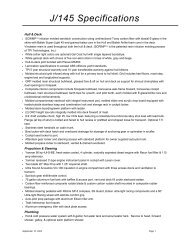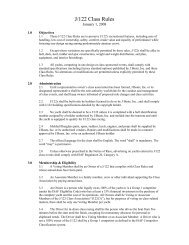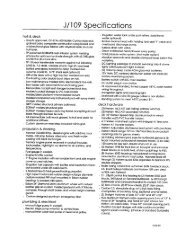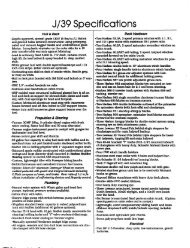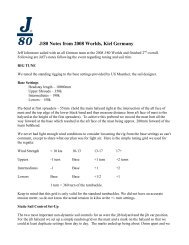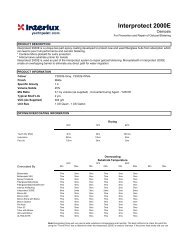J105 Owner Manual 2012.pdf - J/Owners
J105 Owner Manual 2012.pdf - J/Owners
J105 Owner Manual 2012.pdf - J/Owners
Create successful ePaper yourself
Turn your PDF publications into a flip-book with our unique Google optimized e-Paper software.
J/105 <strong>Owner</strong> Guide ...................................................................................................................................................................................................................................................... 39 <br />
Galley Stove <br />
A 2-‐burner non-‐pressurized alcohol stove is part of the Systems Group Option and is in "ready-to-‐use"<br />
condition. It is significantly safer than older pressurized models and is a remarkably fast <br />
heating stove, nearly equaling the heating of home ranges. It can boil a 2 quart pot of water in 8 <br />
to 10 minutes. Engineered with high quality stainless steel, it will last for years with proper care. <br />
Be sure to read the stove manufacturer's instructions on use and the filling of its canisters. You <br />
will find it easy to use as long as you follow proper precautions. <br />
To begin stove operation, you must first fill the canisters with alcohol fuel. Inside the canister is <br />
a "wick-‐like" material that absorbs alcohol. Once filled, the alcohol will last three to four hours. <br />
If the stove is not in use for a long period of time, place the rubber seal over the burner opening <br />
to reduce evaporation of the alcohol. <br />
Safety Equipment <br />
You can never be prepared enough for emergencies that may arise at sea. During commissioning <br />
of your J/105, triple check that you have all required safety gear and adequate spares aboard. <br />
Make it a policy to thoroughly brief any first time crew members with emergency procedures <br />
including man-‐over-‐board, fire, and sinking. Please contact your local U.S. Coast Guard office for <br />
up to date USCG safety requirements. <br />
IT IS THE OWNER’S RESPONSIBILITY TO COMPLY WITH ALL FEDERAL AND STATE REGULATIONS WITH <br />
RESPECT TO SAFETY EQUIPMENT; OPERATION OF THEIR VESSEL; AND SAFETY OF ALL PASSENGERS <br />
Maintenance Tips <br />
Even though modern construction has helped reduce upkeep, regular attention should be given <br />
to the maintenance of your boat. This includes the fiberglass exterior surfaces, the interior wood <br />
surfaces, and the mechanical and electrical systems. <br />
A well-‐maintained boat will not only bring you years of enjoyment, but most importantly, will <br />
bring you greater personal pride and joy. <br />
Fiberglass/Gelcoat <br />
Apply a marine wax to the hull topsides at least twice annually to preserve the “factory fresh” <br />
appearance for many years. Be sure fiberglass surfaces are clean and free of salt before waxing. <br />
Abrasive cleansers should never be used for general cleaning as they can severely mar the shiny <br />
gelcoat finish. <br />
Bottom Paint <br />
Keeping your bottom clean is of paramount importance as it not only keeps off bottom growth, <br />
but maintains passage-‐making speed. Even though you have applied anti-‐fouling paint, take a <br />
swim once a month or so (or hire a diver) and scrub the bottom and propeller with a scrub brush <br />
or lightly abrasive sponge pad.



